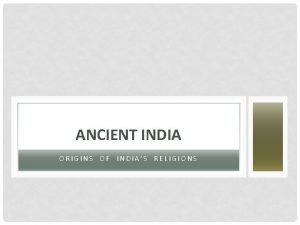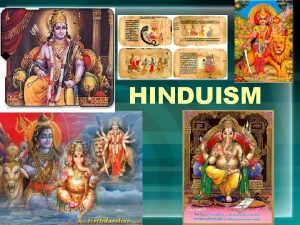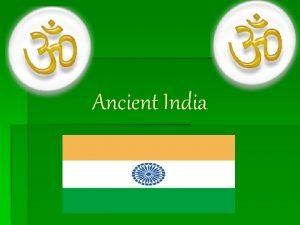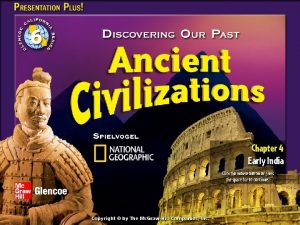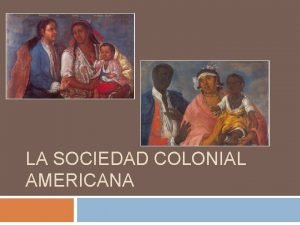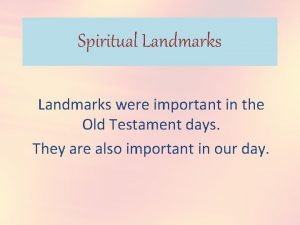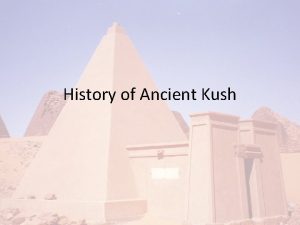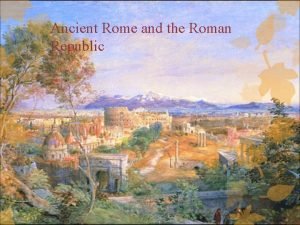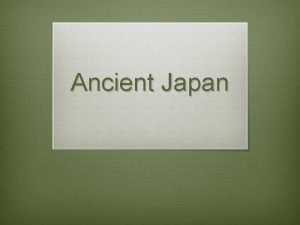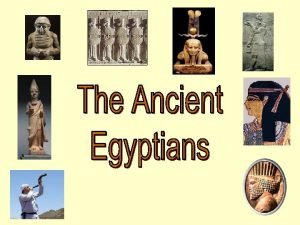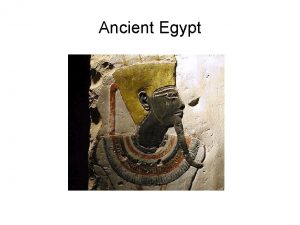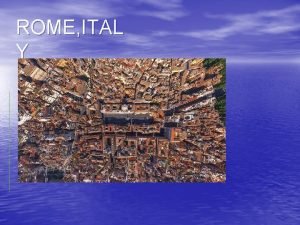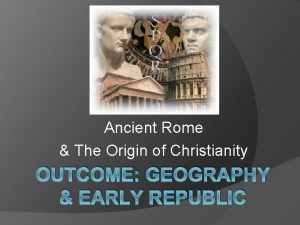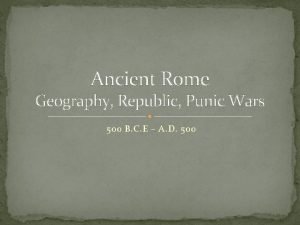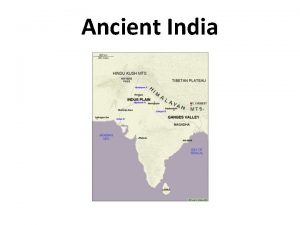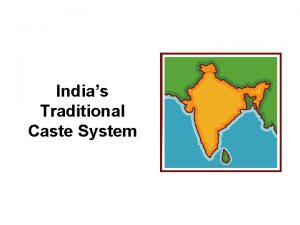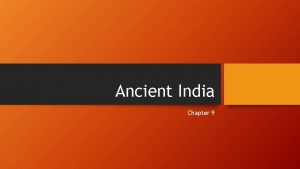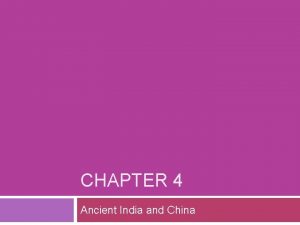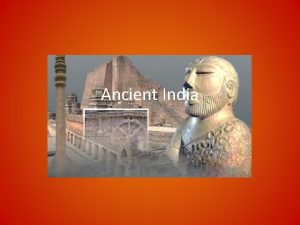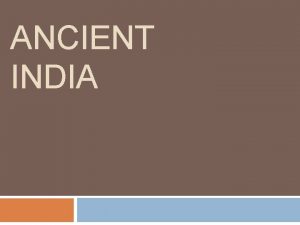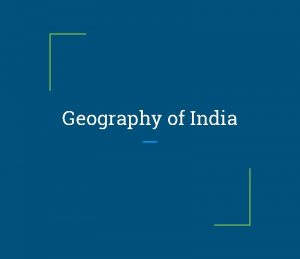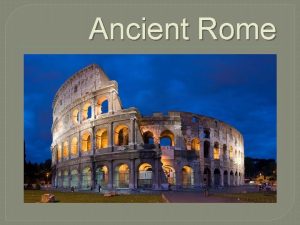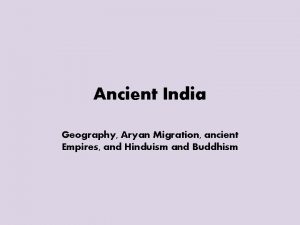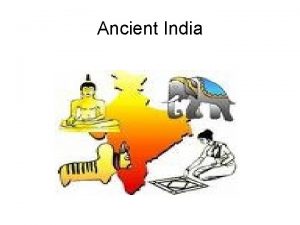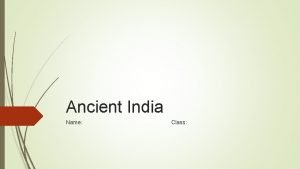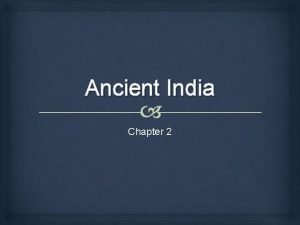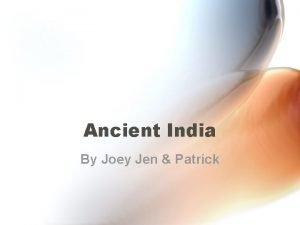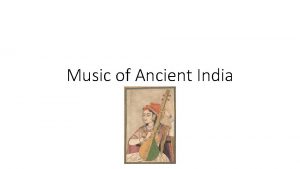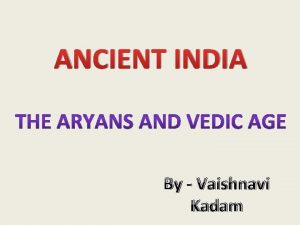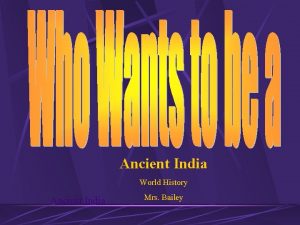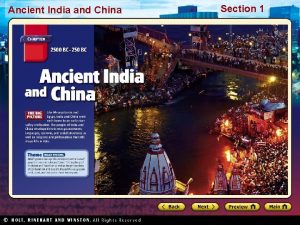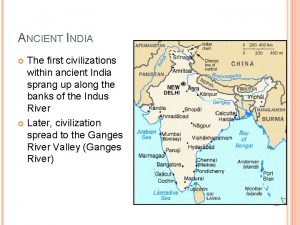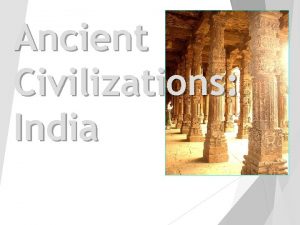Ancient India Indias Geography India is a land









![Varna – Social Level Brahmins Kshatriyas Vaishyas Shudras Pariahs [Harijan] Untouchables Varna – Social Level Brahmins Kshatriyas Vaishyas Shudras Pariahs [Harijan] Untouchables](https://slidetodoc.com/presentation_image_h2/a0c49c93f1cad35ea1ab6411b0cdfeaf/image-10.jpg)























- Slides: 33

Ancient India

India’s Geography • India is a land of great Diversity – Has over 110 different languages with over 1100 dialects spoken – Geography ranges from fertile forests to desert, to high mountains • Indian Subcontinent – Subcontinent of Asia – Divided from Asia by Himalaya and Hindu Kush mountain ranges

Mohenjo-Daro Organization: These cities were very carefully planned. Harappa and Mohenjo-Daro Population: It is thought that Harappa had up to 35, 000 people at its height and that Mohenjo. Daro has between 35, 00040, 000 people.

Aryan Invasion/Migration • Aryans come to India – 1500 BCE – group of Indo-European nomads • Warfare = were advanced fighters • Eventually spread throughout India

Aryan (Vedic Era) • 1500 -400 BCE • Government – ruler not above the law, small chiefdoms, could be replaced. – Rajas – Princes of the Aryans, warring chieftains who fought each other, seizing territory and prisoners • Major Accomplishments or Characteristics – – creation and use of Sanskrit Vedas written pastoral life for most people creation of caste system

Aryan (Vedic Age) • Influence of Iron: Iron tools allowed for improvements in Agriculture, including the plow • Agriculture – Tools and irrigation = clear jungle around the Ganges – Basic crops – grains = north, rice = south; cotton and spices

Aryan (Vedic Age) • Family Life: Dominated most social activity – Extended family – Patriarchal = male dominated; men inherit property and boys educated – Arranged marriages (parents do this for their young children) • usually for political and economic reasons • Status of women – Very low social status – Suttee (Sati) – women expected to thrown themselves on the crematory fires of their dead husbands; refusal = disgrace

Sanskrit Writing • The written language enabled the peoples to write down their stories and religious chants and rituals • Eventually became the sacred texts of Hinduism, the Vedas

The Vedas • 1200 BCE-600 BCE • Written in Sanskrit • Hindu core of beliefs – – – Hymns & poems Religious prayers Magical spells Lists of the gods Rig Veda = oldest work
![Varna Social Level Brahmins Kshatriyas Vaishyas Shudras Pariahs Harijan Untouchables Varna – Social Level Brahmins Kshatriyas Vaishyas Shudras Pariahs [Harijan] Untouchables](https://slidetodoc.com/presentation_image_h2/a0c49c93f1cad35ea1ab6411b0cdfeaf/image-10.jpg)
Varna – Social Level Brahmins Kshatriyas Vaishyas Shudras Pariahs [Harijan] Untouchables

Caste System • Who is… – – The The mouth? arms? legs? feet? Brahmins Kshatriyas Vaishyas Shudras

Caste System • System of social division in India • Originally just four castes – – Priests = Brahmins Warriors and princes = Kshatryias Merchants, large landowners, and artisans = Vaishya Small farmers/manual laborers = Shudra • Each caste has it’s own Dharma, or duty. You must obey the dharma of your caste to earn good Karma and be able to be reincarnated at a higher caste in the next life

Caste System • System was not originally particularly rigid – Contained opportunity for mobility – Intermarriage between castes was allowed • System became increasingly complex and rigid as time went on – Hundreds of castes – No social contact between them – At bottom, were the “untouchables”

Untouchables • About 5% of the population of India. They are required to perform the dirtiest jobs dealing with trash, human waste, and death. • So low that they are not a part of the caste system • They were required to carry of noisemaker to warn people of the approach so they would not accidentally run into someone. • Discrimination against them continues today, even though the caste system has been declared illegal.

Hinduism • Originally polytheistic Aum, or Om Seen as the sound of the universe • Over time, three of the most important gods merged together to create a three-part monotheistic deity called Brahman – Brahma (creator) – Vishnu (protector) – Shiva (destroyer) • Multiple Gods – Hindus believe that Brahman is too complex for people to understand so it is divided into the many different gods and goddesses of Hinduism to simplify it. – Often seen as polytheistic, but some argue that it is not because all of the gods are part of the one universal god.

Hinduism • Every living thing is related • All living things have souls • Atman: The Essential self or the Soul; essence of Brahman that is inside every living thing • Reincarnation – Each soul is reborn in the body of some other creature over and over again

Moksha: The ultimate goal of Hinduism. To achieve Shanti, or ultimate peace. To be released from the cycle of death and rebirth. Karma All of the actions in this life that affect your next life. Has nothing to do with revenge or retribution Moksha Dharma Union with Brahman. Your Duty. The rules you must follow to earn good Karma. Release from Samsara Being stuck in the cycle of death and rebirth. Suffering

Hindus consider all life to be sacred and so they practice the principle of ahinsa, or non-violence. Because of this many Hindus are vegetarian Cows are Sacred in India because they are seen as the most generous of all animals. The sacred texts of Hinduism are the Vedas and Upanishads.

Yoga • Was developed as a method of training the body to achieve oneness with Brahman. • It is a form of meditation • Mastery over body, mind, and emotions

Gautama the Buddha • Gurus appear around 600 BCE who argued that Hinduism had become too materialistic and that people should be more spiritual • Foremost guru was Gautama the Buddha – Means “Enlightened One” – Search for permanent escape from wheel of suffering – Argued that desire for material goods causes suffering

Siddhartha Gautama: Prince turned Buddha • Birth: was born into the wealthy warrior caste. It is believed that before his birth his mother had a dream of an elephant piercing her side with its tusk. This was interpreted to mean that he would be a great leader or a wandering holy man. • Childhood: his mother died shortly after his birth. His father lavished him with wealth so he would never want to leave the palace. He was completely sheltered from the outside world.

Siddhartha Gautama • • The Three Visions Siddhartha grew up never knowing much about the outside world. He married young and had a son. When he was in his 20’s he went outside the palace and experienced three visions which changed his life. • • – – – • • The saw someone in advanced old age. He saw a very sick person He saw a dead body. Siddhartha had never before been aware of human suffering. He felt his life was a lie and abandoned it to become an ascetic, or wandering holy man in an attempt to find a way to end human suffering.

Siddhartha Gautama • Seeking Truth – Siddhartha tried many different ways of achieving enlightenment. – He tried mediation, fasting, physical discomfort, but none along worked for him. – He almost starved himself to death at one point. – After that he knew he needed to try something different. • Enlightenment – Siddhartha decided that he would meditate until he discovered the way to end human suffering. – Bodhi Tree: He sat under a Bodhi tree and he mediated for 40 days amidst temptation, and at the end said that he was “awake” he had achieved, Nirvana, or Enlightenment. This is when he became the Buddha, or enlightened one.

Teachings of the Buddha • The Buddha gave his first sermon in the deer park where he taught the four main ideas of his teachings • Four Noble Truths – All life is full of suffering – We suffer because we desire things that are illusions. We want material possessions – The way to not suffer is to overcome our desires – To do that, one must follow the Eightfold path, or Middle Way

Achievement of Nirvana • 8 -step process to escape wheel of suffering – Included non-violence, rejection of selfish desires, cultivating compassion and honesty, cleansing mind of evil thoughts, etc. – Nirvana—permanent escape from wheel of suffering – Attainment of permanent peace and tranquility

The Eightfold Path (Middle Way) 1. Right view - One must understand the four noble truths. 2. Right intention - Know what you really want 3. Right speech - Speak truth and speak well of others. 4. Right action - Do not kill, steal, lie, be unchaste, or take drugs or alcohol. 5. Right livelihood - Don’t do a job that harms others. 6. Right effort - Do your best, always 7. Right mindfulness - Keep control of yourself and your urges. 8. Right concentration - One must meditate to understand the world.

Buddha’s Life • Buddha practices what he preached – Only owned simple robe, walking stick, and wooden bowl – Always slept outside and walked everywhere he went – Presented his creed in a simple language – Treated all persons equally – Many people attracted to him as a result • Millions of converts across Asia

Teachings • Caste System: The Buddha rejected the caste system. He said all people were capable of achieving enlightenment in one lifetime. Although not everyone did, so Buddhism does believe in reincarnation. • Ahinsa: Taught non-violence, same as Hinduism • Meditation: Taught that one should meditate. Yoga and Martial arts are seen as a form of mediation. • Reincarnation: The Buddha taught the belief of Samsara, or Reincarnation. As long as one is tied to material possessions of this earth and does not achieve enlightenment then one will have suffering. • Nirvana: The ultimate goal of Buddhism, to be released from the cycle of death and rebirth.

Spread of Buddhism • Convents and Monasteries: The Buddha had many followers, both men and women. He did not discriminate based on gender. • Death of the Buddha: He died of food poisoning at the home of a friend. • Scriptures: His teachings were collected in the Tripitika, or three baskets of wisdom.

Buddhist Traditions • Buddhism ultimately split into 2 traditions • Theravada (Little Vehicle) – Do not view Buddha as a god, was just a great man – Strict practice and dediction • Mahayana (Big Vehicle) – Largest of the two – Buddha was human incarnation of Brahma; Buddha was a god • Led to worship of Buddha, creation of idols, elaborate rituals, and temples – Vow not to reach Nirvana, instead stay to help others reach Nirvana first

Stupa • Shrine that houses Buddhist relics

Pagodas • Evolved from Stupas, they are usually Buddhist temples or shrines

Caste System Caste Brahmins Occupation Priests Function Led religious ceremonies Fighting Herdsmen, carried out trade Kshatriyas Vaisyas Warriors Merchants Sudras Untouchables (OUTSIDE CASTE SYSTEM) Peasants Manual labor Slaves/criminals Menial, degrading tasks
 Ancient india vs ancient china
Ancient india vs ancient china Indias religions
Indias religions Indias religions
Indias religions Is hinduism the first religion
Is hinduism the first religion Indias first empire
Indias first empire Indias first civilization
Indias first civilization Flota de indias ruta
Flota de indias ruta India caste system
India caste system Virreinatos capitanias y audiencias
Virreinatos capitanias y audiencias Indias first empire
Indias first empire What are landforms
What are landforms A pointed piece of land extending into the sea
A pointed piece of land extending into the sea Spiritual ancient landmark
Spiritual ancient landmark Ancient land of punt
Ancient land of punt Ancient greece land
Ancient greece land Means of communication from ancient to modern
Means of communication from ancient to modern Site:slidetodoc.com
Site:slidetodoc.com Mixed land use ap human geography definition
Mixed land use ap human geography definition Ap human geography models
Ap human geography models Sparta greece geography
Sparta greece geography Map of kush empire
Map of kush empire Rome geography
Rome geography Greece geography map
Greece geography map Ancient greek map
Ancient greek map Ancient japan geography
Ancient japan geography Ancient egypt civilization geography
Ancient egypt civilization geography Nubia
Nubia Describe the geography of ancient greece
Describe the geography of ancient greece China geography
China geography Geography of ancient greece
Geography of ancient greece Monti doc rome
Monti doc rome Ancient china on a map
Ancient china on a map Ancient rome outcomes geography and early republic
Ancient rome outcomes geography and early republic Carthage geography
Carthage geography

